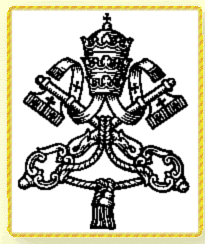
Fr. Erik posts on the many horrific items he has found in his church have amused me greatly because I have found many similar items in the churches where I have served, but today I found a real treasure amidst the items destined for the dumpster.
The choir loft at my church has two closets which are filled with everything from 70's hymnals to old door frames. This morning I was clearing out some of the 70's hymnals when I found a thick black book covered with a homemade covering of black fabric. I opened it and found page after page of Gregorian chant. Real Gregorian chant, Latin, complete with 4 line staff and square notes!
old door frames. This morning I was clearing out some of the 70's hymnals when I found a thick black book covered with a homemade covering of black fabric. I opened it and found page after page of Gregorian chant. Real Gregorian chant, Latin, complete with 4 line staff and square notes!
I flipped to the front of the book and read the title: Antiphonarium Romanum. I have never seen one of these before, but its fascinating. Now I have to find a way to use it. I wish I knew how to read real Gregorian Chant. Time to learn, huh?
The choir loft at my church has two closets which are filled with everything from 70's hymnals to
 old door frames. This morning I was clearing out some of the 70's hymnals when I found a thick black book covered with a homemade covering of black fabric. I opened it and found page after page of Gregorian chant. Real Gregorian chant, Latin, complete with 4 line staff and square notes!
old door frames. This morning I was clearing out some of the 70's hymnals when I found a thick black book covered with a homemade covering of black fabric. I opened it and found page after page of Gregorian chant. Real Gregorian chant, Latin, complete with 4 line staff and square notes!I flipped to the front of the book and read the title: Antiphonarium Romanum. I have never seen one of these before, but its fascinating. Now I have to find a way to use it. I wish I knew how to read real Gregorian Chant. Time to learn, huh?
 Update: Brian helped me with the first part of reading chant: identifying the key. From there I took my newfound knowledge and found a few good pages online. The first is very simple and explains the different neumes and groupings of neumes. The second is more technical and in depth.
Update: Brian helped me with the first part of reading chant: identifying the key. From there I took my newfound knowledge and found a few good pages online. The first is very simple and explains the different neumes and groupings of neumes. The second is more technical and in depth.It's official, I'm hooked. I still can't get used to the idea that notes placed one over the other to mean to sing the bottom one first and the upper one second, but I am getting it.










4 comments:
It's a lot easier than it looks.
Think of this - if your clef looks kinda like a "C" shape, the note that clef rests on is "do". If your clef has a little tail on it, the note that clef rests on is "fa".
All notes (neums) have the same length to them, except for the dotted notes and the notes with little lines above them.
BMP
Thanks, I was intimidated when I first looked at it. It all looked so unfamiliar, but it's starting to make sense now.
Thankfully it was you that found them. If it was someone like the nutcases at St. Terri's, they would have been dumpster bound for sure. Had it been me, they'd be in my totes right beside my desk here at CV Studios New England :).
BMP
It's coming home with me for sure. :-)
It will go perfectly with the Sanctus bells that I saved from the dumpster a few years ago.
I wish there were more things like this, but it seems my predecessors only thought paper missalettes from 1980 worth keeping.
Another interesting item I found was a large number of People's Mass Books from 1970. It was interesting to see what the Mass was like after Vatican II, but before the current Sacramentary was approved.
I was a little surprised to confirm that the texts are very similar to the changes which are now being proposed. Funny how we try so hard to change, only to decide that we shouldn't have changed.
Post a Comment